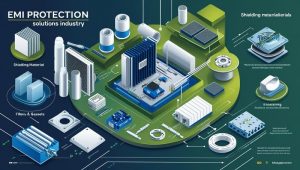The electromagnetic interference (EMI) protection solutions market is entering a transformative phase, driven by the proliferation of advanced electronic systems, rising signal frequencies, and the increasing integration of smart technologies across industries. As devices become more compact, powerful, and interconnected, traditional EMI shielding methods are giving way to cutting-edge technologies designed to meet the evolving needs of high-performance environments. These emerging technologies are not only improving shielding effectiveness but also opening up new possibilities for miniaturization, durability, and design flexibility.
One of the most significant technological advancements reshaping the EMI protection market is the development of nanomaterial-based shielding solutions. Nanomaterials such as graphene, carbon nanotubes, and metal oxide nanoparticles offer exceptional conductivity and lightweight properties. These materials can be incorporated into coatings, films, or composites to provide superior EMI shielding performance at significantly reduced thickness and weight. Their adaptability makes them ideal for modern applications in aerospace, wearable electronics, and mobile devices where space and weight constraints are critical.
Download PDF Brochure @ https://www.marketsandmarkets.com/pdfdownloadNew.asp?id=105681800

Another groundbreaking technology is the emergence of conductive polymers and elastomers. These materials are highly flexible, corrosion-resistant, and can be easily molded into complex geometries, making them suitable for shielding irregularly shaped components. Conductive polymers are increasingly used in consumer electronics, automotive systems, and medical devices where conventional metallic shields are either impractical or too rigid. Their ability to combine electromagnetic shielding with thermal management and mechanical protection adds to their appeal in multifunctional design environments.
The shift toward flexible and printed electronics is also influencing the evolution of EMI protection technologies. Innovations in printable conductive inks and flexible substrates are enabling the development of EMI shielding layers that can be integrated directly into circuit boards or device casings during the manufacturing process. This not only reduces production complexity and cost but also enhances design freedom for next-generation electronics. As flexible electronics continue to gain traction in applications such as foldable smartphones and smart textiles, demand for compatible EMI protection solutions is expected to rise.
Advanced EMI absorption technologies are also gaining momentum. Unlike traditional shielding methods that reflect electromagnetic waves, absorptive materials convert EMI into heat or dissipate it harmlessly. These materials are particularly valuable in environments with high-density electronics and high-frequency signals, such as 5G base stations, radar systems, and military-grade electronics. The ability to minimize cross-talk and signal degradation without creating additional reflections is critical in such applications, making absorptive shielding materials a growing focus of research and development.
Digital twin and AI-driven simulation tools are transforming how EMI protection is designed and tested. Engineers can now model complex electromagnetic environments and evaluate shielding performance virtually before a prototype is built. This reduces development time, enhances product reliability, and ensures compliance with increasingly stringent EMC regulations. As electronics become more sophisticated, the use of predictive design tools is expected to become standard practice in EMI protection engineering.
In conclusion, the EMI protection solutions market is being reshaped by a wave of emerging technologies that offer enhanced performance, greater integration potential, and adaptability to new electronic form factors. From nanomaterials and flexible shielding solutions to absorptive materials and AI-based design tools, these innovations are setting the stage for a smarter, lighter, and more efficient generation of EMI protection systems across industries.
